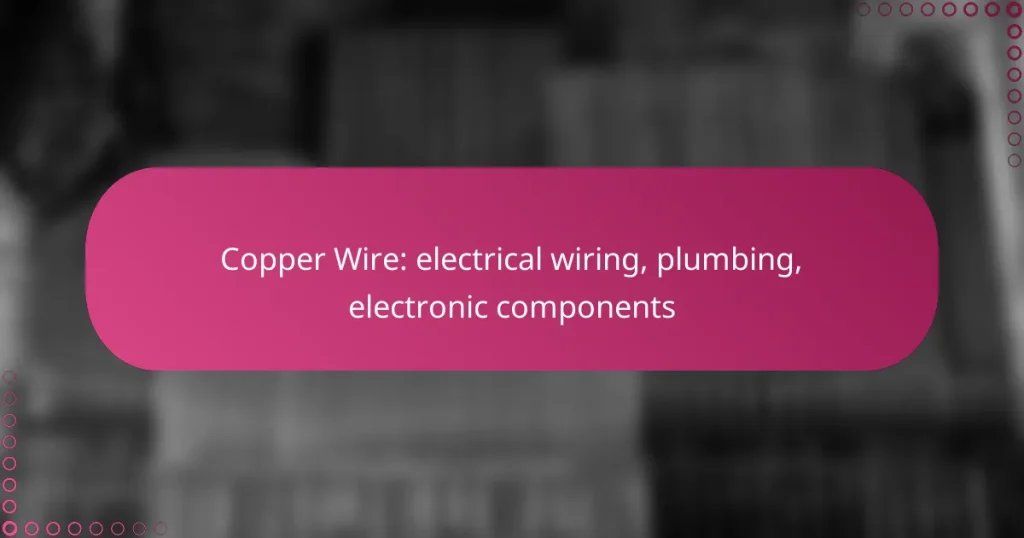Copper wire is a fundamental component in electrical wiring, plumbing, and electronic devices, prized for its exceptional conductivity and durability. Its versatility allows it to be utilized in a wide range of applications, from residential to industrial settings, while its resistance to corrosion makes it ideal for plumbing systems. Selecting the right gauge of copper wire is essential for optimizing performance and safety in any electrical installation.

What are the best uses of copper wire in electrical wiring?
Copper wire is widely used in electrical wiring due to its excellent conductivity, durability, and flexibility. Its applications span residential, commercial, and industrial settings, making it a versatile choice for various electrical systems.
Residential electrical systems
In residential electrical systems, copper wire is primarily used for wiring outlets, switches, and lighting fixtures. Its high conductivity ensures efficient power delivery, which is essential for everyday appliances and devices.
When selecting copper wire for home use, consider the gauge, which affects the amount of current the wire can safely carry. Common gauges for residential wiring include 14 AWG for lighting circuits and 12 AWG for outlets.
Commercial electrical installations
Commercial electrical installations often require copper wire for larger systems, including lighting, HVAC, and power distribution. The reliability of copper wire helps ensure that businesses operate smoothly without electrical failures.
In commercial settings, it’s crucial to adhere to local electrical codes and standards, which may dictate wire types and installation practices. For instance, using THHN (Thermoplastic High Heat-resistant Nylon-coated) copper wire is common in commercial applications due to its insulation properties.
Industrial applications
Copper wire plays a vital role in industrial applications, such as machinery, motors, and control systems. Its ability to handle high currents makes it suitable for heavy-duty equipment that requires reliable power sources.
When using copper wire in industrial settings, consider factors like temperature ratings and environmental conditions. For example, using bare copper wire may be necessary in certain environments, while insulated wire is preferred in others to prevent short circuits and ensure safety.

How to choose the right copper wire gauge?
Selecting the appropriate copper wire gauge is crucial for ensuring safety and efficiency in electrical systems. The wire gauge affects the current-carrying capacity, resistance, and overall performance of the wiring in applications such as electrical wiring, plumbing, and electronic components.
AWG sizing chart
The American Wire Gauge (AWG) sizing system is used to determine the diameter of copper wire. A lower gauge number indicates a thicker wire, which can carry more current. For example, a 10 AWG wire can handle approximately 30 amps, while a 14 AWG wire is suitable for around 15 amps.
Here’s a brief overview of common AWG sizes and their corresponding ampacity:
- 10 AWG: 30 amps
- 12 AWG: 20 amps
- 14 AWG: 15 amps
- 16 AWG: 10 amps
Voltage drop considerations
Voltage drop occurs when the voltage at the load end of the wire is lower than at the source due to resistance in the wire. This can lead to inefficient operation of electrical devices. To minimize voltage drop, it’s essential to choose a wire gauge that matches the length of the run and the load current.
A general rule of thumb is to keep voltage drop below 3% for optimal performance. For longer runs, consider using a thicker wire gauge to reduce resistance and maintain voltage levels. For instance, if you are running a circuit over 100 feet, opting for a 12 AWG wire instead of a 14 AWG wire may be beneficial.

What are the benefits of using copper wire in plumbing?
Copper wire offers several advantages in plumbing applications, including excellent corrosion resistance and impressive durability. These properties make it a preferred choice for various plumbing systems, ensuring longevity and reliability in water transport.
Corrosion resistance
Copper wire is highly resistant to corrosion, which is crucial in plumbing where exposure to moisture and various chemicals is common. This resistance helps prevent the degradation of the wire over time, maintaining its integrity and functionality. In environments with high acidity or alkalinity, copper’s natural properties protect it from rust and other forms of deterioration.
For instance, copper plumbing systems can last for decades without significant wear, making them a cost-effective solution in the long run. Regular inspections can further enhance the lifespan by identifying any potential issues early.
Durability and longevity
The durability of copper wire in plumbing is a significant benefit, as it can withstand high pressures and temperatures. This robustness ensures that plumbing systems remain operational even under challenging conditions. Copper’s ability to handle thermal expansion and contraction without cracking adds to its reliability.
Typically, copper plumbing can last over 50 years, significantly reducing the need for frequent replacements. Homeowners should consider investing in copper systems for their long-term performance and reduced maintenance costs compared to other materials.

What are the key specifications of copper wire for electronics?
Copper wire for electronics is primarily defined by its conductivity, insulation types, and gauge. These specifications determine the wire’s performance in various applications, influencing efficiency, safety, and compatibility with electronic components.
Conductivity ratings
Conductivity ratings indicate how well a copper wire can transmit electrical current. High conductivity is essential for minimizing energy loss, with pure copper offering the best performance. Generally, copper wire has a conductivity rating of around 58-60 S/m, making it a preferred choice for electronic applications.
When selecting copper wire, consider the specific conductivity requirements of your project. For instance, wires used in high-frequency applications may need to be of higher purity to reduce signal loss. Always check the manufacturer’s specifications to ensure the wire meets your needs.
Insulation types
The insulation type of copper wire is crucial for protecting against electrical shorts and environmental factors. Common insulation materials include PVC, Teflon, and silicone, each offering different levels of heat resistance and flexibility. For example, Teflon insulation can withstand higher temperatures, making it suitable for demanding applications.
When choosing insulation, consider the operating environment and temperature range. For indoor electronics, PVC may suffice, while outdoor or high-temperature applications might require more robust options like silicone. Always verify that the insulation type complies with relevant safety standards to ensure reliable performance.

How does copper wire compare to aluminum wire?
Copper wire generally offers superior conductivity and durability compared to aluminum wire, making it a preferred choice for many electrical applications. However, aluminum wire is lighter and often less expensive, which can influence its use in specific scenarios.
Conductivity differences
Copper wire has a higher electrical conductivity than aluminum, which means it can carry more current with less resistance. This property makes copper ideal for applications requiring efficient energy transfer, such as in residential wiring and electronic components.
Aluminum, while less conductive, can still be effective for certain uses, particularly in overhead power lines where weight is a significant consideration. However, it typically requires larger gauge sizes to match the performance of copper, which can complicate installation and increase material costs.
Cost considerations
When comparing costs, aluminum wire is usually cheaper than copper wire, making it attractive for budget-conscious projects. However, the overall cost-effectiveness can vary depending on the application, as the need for larger aluminum wire can offset initial savings.
Additionally, installation costs may differ. Copper’s durability often leads to lower maintenance expenses over time, while aluminum may require more frequent inspections and connections to prevent issues like oxidation. Therefore, it’s essential to weigh both upfront and long-term costs when choosing between the two materials.

What are the safety standards for copper wire installations?
Safety standards for copper wire installations ensure that electrical systems operate safely and efficiently. Compliance with these standards minimizes risks such as electrical fires, shocks, and equipment damage.
National Electrical Code (NEC) compliance
The National Electrical Code (NEC) sets the baseline for safe electrical installations across the United States. It includes guidelines on wire sizing, insulation types, and installation methods to prevent hazards. For instance, using copper wire of appropriate gauge for the intended load is crucial to avoid overheating.
When installing copper wire, ensure that it meets NEC requirements for grounding and bonding. This helps protect against electrical faults and enhances overall safety. Regular updates to the NEC mean it’s essential to stay informed about the latest revisions and amendments.
Local building codes
Local building codes may impose additional requirements beyond NEC standards, reflecting regional safety concerns and environmental factors. These codes can dictate specific installation practices, such as the types of conduits or protective measures needed for copper wiring in different settings.
Before beginning any installation, check with local authorities to ensure compliance with applicable building codes. This may include obtaining necessary permits and inspections, which can vary significantly by municipality. Adhering to local codes not only ensures safety but also avoids potential fines or legal issues.

What are the emerging trends in copper wire technology?
Emerging trends in copper wire technology focus on enhancing efficiency, sustainability, and performance. Innovations include the development of high-conductivity alloys, improved insulation materials, and smart wiring solutions that integrate with IoT devices.
High-Conductivity Alloys
High-conductivity copper alloys are gaining traction as they offer better performance than traditional copper. These alloys can reduce energy loss in electrical applications, making them suitable for power distribution and electronic components.
When selecting high-conductivity alloys, consider their specific applications and the required conductivity levels. For instance, some alloys may provide up to 30% more conductivity than standard copper, which can significantly impact efficiency in electrical systems.
Improved Insulation Materials
Advancements in insulation materials are crucial for enhancing the safety and longevity of copper wiring. New materials, such as cross-linked polyethylene (XLPE) and thermoplastic elastomers, offer better thermal resistance and durability.
Choosing the right insulation material depends on the application environment. For example, XLPE is often preferred in high-voltage applications due to its excellent dielectric properties and resistance to heat and moisture.
Smart Wiring Solutions
Smart wiring solutions are becoming increasingly popular as they allow for better integration with smart home and industrial systems. These solutions often include sensors and connectivity features that enable real-time monitoring and control of electrical systems.
When implementing smart wiring, consider compatibility with existing systems and the potential for future upgrades. Investing in smart technology can lead to energy savings and improved operational efficiency over time.


